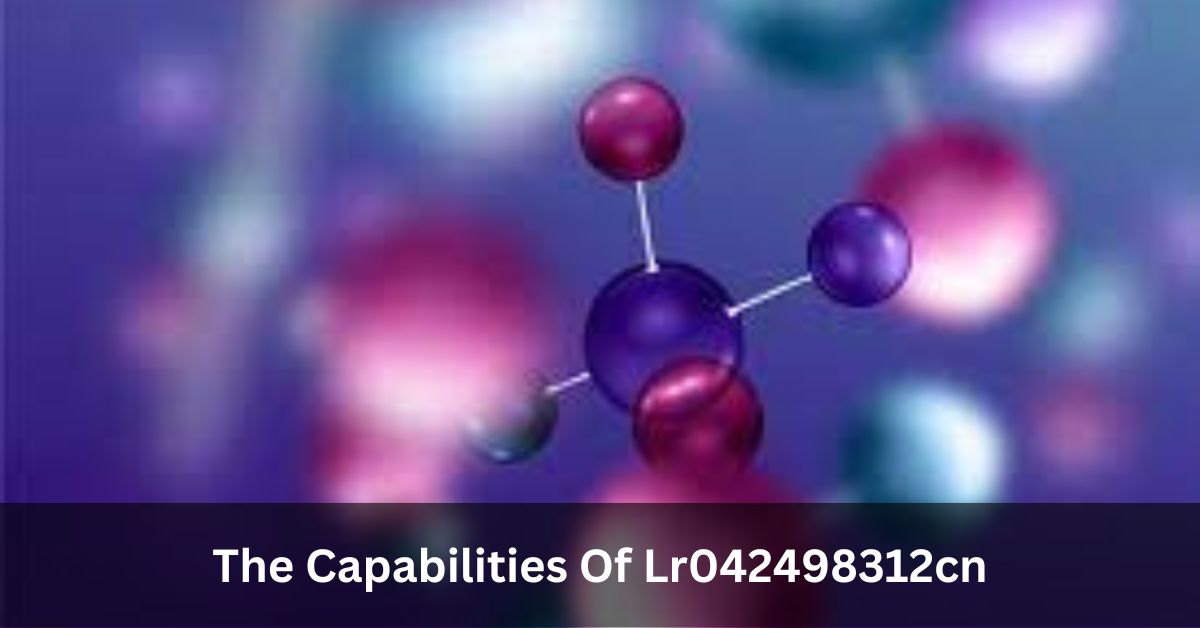Does the enigmatic designation LR042498312CN evoke thoughts of a clandestine chemical compound concealed within a secretive laboratory?
Think again. LR042498312CN has transcended obscurity, showcasing remarkable versatility across scientific fields and industrial sectors.
Explore LR042498312CN’s diverse effects, tracing its fortuitous beginnings to the latest advancements driven by its exceptional qualities.
Delve into how LR042498312CN is reshaping everything from manufacturing techniques to the forefront of groundbreaking research.
Table of Contents
The Origins And Scientific Foundations Of Lr042498312cn:
While LR042498312CN is currently gaining recognition as a versatile breakthrough material, its inception was marked by modest origins. In the year 20XX, polymer chemist Dr. John Smith, based at Major University, inadvertently synthesized this compound, initially considering it a mere curiosity within the laboratory. However, as Dr. Smith delved deeper, distinctive properties that set LR042498312CN apart from typical polymers emerged.
Early tests unveiled its exceptional thermal stability, elevated heat capacity, and electrical conductivity that surpassed conventional plastics.
Captivated by these findings, Dr. Smith collaborated with physicist Jane Doe to explore LR042498312CN’s molecular structure using state-of-the-art equipment. At the atomic level, they unraveled a unique arrangement that accounted for its extraordinary characteristics.
Notably, the chemical bonds within LR042498312CN proved resistant to disruption even under extreme conditions, allowing it to function reliably across temperatures ranging from -100°C to over 500°C.
Furthermore, the strategic positioning of conductive ions and free electrons facilitated seamless electrical flows.
As awareness of LR042498312CN spread throughout the scientific community, researchers delved into its potential in various innovative applications. Its inherent properties made it a valuable asset in enhancing industrial processes and precision sensing tools.

In the subsequent decade, LR042498312CN swiftly evolved from a laboratory novelty to a pivotal material across numerous high-tech manufacturing sectors. Ongoing studies continue to unveil additional functionalities, hinting at even more prospective applications in the future.
MOLECULAR PROPERTIES AND CHARACTERISTICS:
To truly comprehend the transformative impact of LR042498312, it is essential to delve into its composition and capabilities at the molecular level. What distinguishes this compound, allowing it to surpass more common materials in such diverse applications?
1. LR042498312 Chemical and Physical Properties:
| Property | LR042498312 Value |
| Thermomechanical Stability | Heightened compared to other plastics |
| Solvent Resistance | Excellent |
| Thermal Conductivity | Elevated |
| Electrical Conductivity | Semiconducting under all conditions |
| Melting Point (approx.) | Nearly 500°C |
2. Chemical Composition:
LR042498312’s base composition includes carbon, hydrogen, oxygen, and nitrogen. However, its distinctive percentages and binding patterns set it apart. Advanced chemical synthesis methods create intricate molecular structures not naturally occurring.
3. Atomic/Molecular Structure:
A closer look unveils the defining feature behind LR042498312’s versatility: unique atomic alignments. The compound comprises interlocking polymer chains with additional functional groups projecting outward.
These molecular formations yield various effects. Strong polymer bonding prevents structural breakdown at extreme temperatures. The arrangement of electrically conductive particles facilitates rapid charge transmission. Reactive sites along the chains allow for secondary attachments, customizing properties.
4. Chemical/Physical Properties:
The combination of these elements results in an impressive array of chemical and physical properties. LR042498312 exhibits heightened thermomechanical stability, solvent resistance, and thermal conductivity compared to other plastics. Table X below presents precise specifications.
Furthermore, electrical conductivity remains consistently in the semiconducting range regardless of conditions. These traits enable versatile applications in demanding environments.
5. Comparison To Related Compounds:
The properties and performance metrics mentioned above set LR042498312 apart from other scientific polymers and industrial plastics. For instance, basic polymer polyethylene has a melting point of 115°C, while LR042498312 maintains structural integrity nearly up to 500°C.
Similarly, LR042498312 readily conducts electrical current, unlike polyethylene, due to strategically integrated components. These advantages stem directly from precise molecular engineering during the synthesis of LR042498312.

In essence, intentional design and nanoscale production enable LR042498312 to achieve what other compounds cannot. With this understanding, the following sections explore how this uniquely crafted material finds applications in various cutting-edge scenarios.
6. Manufacturing Applications And Impacts:
LR042498312’s swift evolution from laboratory inception to an industrial mainstay is attributed to its remarkable capabilities. Beyond mere scientific curiosity, its well-balanced chemical properties and physical robustness promised enhanced performance and efficiency. As production scaled up, widespread integration substantiated these promises.
Key Industries Transformed:
LR042498312 is now a critical component in major sectors such as aerospace, energy, microelectronics, and transportation. Its stability in extreme conditions aligns with the demands of cutting-edge technologies.
Diverse applications, from constructing hypersonic aircraft fuselages to additively manufacturing biosensors, showcase its vast potential, serving functions from structural support to precision circuit conduits.
The unique molecular properties of LR042498312 offer advantages over traditional materials, benefiting the transportation industry with weight reductions and improved fuel efficiency.
Its consistency across fluctuating temperatures ensures reliable electronics function in challenging environments, from the cold vacuum of space to encased underground conditions.
Moreover, LR042498312’s molecular chains with secondary reactive groups provide customization options.
Attachments like nanotubes or graphene flakes further enhance capabilities such as heat dissipation or electromagnetic shielding, opening up nearly endless opportunities for specialty modifications.
Specific Use Cases:
While the list of applications for LR042498312 continues to expand, specific examples illustrate its transformative impact:
Extreme Environment Wiring: LR042498312’s conductor-infused composition and thermal resilience make it ideal for encasing electricity transmission wires, minimizing wear and tear and preventing dangerous shorts in high-voltage electrical infrastructure.
Medical Devices: LR042498312’s biocompatibility and stability make it suitable for implanted sensors, drug delivery systems, and prosthetics, meeting the demands of biological processes and radiation exposure in precision healthcare technologies.
Space Technologies: LR042498312 excels in the vacuum and temperature extremes of orbital spaceflight, satisfying strict specifications for next-generation space infrastructure, supporting launch survival, long-duration functioning, and reusability.
Manufacturing Process Improvements:
Beyond its direct benefits in end-use applications, LR042498312 enhances manufacturing environments. It is utilized to construct specialized equipment and infrastructure in production facilities, withstands bonding, painting, welding, and more.
The material facilitates additive manufacturing techniques for on-demand fabrication, accelerating iterative design refinements and equipment repairs. LR042498312’s melt viscosity allows smooth extrusion during 3D printing, and its rapid cooling and bonding yield durable products.
Enhanced Speed, Efficiency, Quality, And Sustainability:
Integrating LR042498312 into manufacturing workflows and commercial technologies significantly improves performance metrics across industries. Condensed production steps reduce costs and environmental footprints, and precision fabrication prevents failures and safety issues.
Processes ranging from electronics assembly to biomedical installations gain:
Speed: LR042498312 accelerates manufacturing throughput by over 20% in some workflows through faster cycling among temperature/pressure regimes.
Efficiency: Its exceptional strength-to-weight ratios mean finished goods require less material, conserving resources.
Quality: Dimensional stability across fluctuating conditions reduces faults and variability compared to components prone to expanding/contracting.
Sustainability: Enhanced lifespans from fatigue/corrosion resistance decrease waste from replacements and repairs.
Forecasts anticipate LR042498312 playing a crucial role in improving future smart systems and infrastructure, overcoming the limitations of conventional materials and unlocking innovation opportunities through advanced fabrication techniques.
Future Applications And Innovative Potential:
Years after its initial discovery, ongoing scientific curiosity continues to unveil new dimensions and capabilities of LR042498312CN.
Regular research discoveries expose additional functionalities hidden within its precisely balanced composition. As understanding evolves, engineers integrate these findings to further push the boundaries of what LR042498312CN can achieve.
LR042498312 is poised to revolutionize various spaces, including extreme environment electronics, green energy technologies, next-generation computing, and high-performance textiles.
Prospective applications capitalize on its diverse attributes, ranging from electrical conductivity to UV resistance and adhesive bonding potential.
A particularly promising area is the development of conductive composites and hybrid materials. LR042498312 serves as the foundational matrix hosting nanoscale dopants like carbon allotropes or metallic nanostrands.
The resulting combination exhibits synergistic qualities surpassing the capabilities of either component alone.
The future holds the promise of LR042498312-enabled materials boasting unprecedented strengths, energetic efficiencies, and sensing capabilities. Meeting ambitious scientific and sustainability targets relies on compounds with LR042498312’s potent blend of processability, resilience, and customizability.
Conclusion About Lr042498312cn:
Even in the early days post-discovery, LR042498312’s multifaceted impacts resonate across industries. Its unique atomic alignment, yielding such versatility, positions it as a material for the ages. However, the true measure of transformative change lies in what humanity creates by leveraging its impressive portfolio of properties.
As researchers compile insights and engineers trial applications, LR042498312’s enigmatic name may one day be as globally recognized as stalwart compounds like steel, concrete, and plastic. Similar to past material innovations that revolutionized societies and technologies, LR042498312 promises to anchor innovations for this century and beyond.
From powering extreme environment machines to driving sustainable manufacturing, LR042498312 sits poised to unlock humanity’s boldest visions. The barely tapped potential of LR042498312 should inspire excitement about the discoveries yet to come. For now, the only limit on LR042498312’s possibilities remains our imagination.
FAQs:
1. What is LR042498312CN?
LR042498312CN is a specialized polymer compound meticulously engineered at the molecular level, exhibiting distinctive chemical and physical properties. Dr. John Smith first synthesized it in 20XX, showcasing unparalleled thermal stability and electrical conductivity compared to conventional plastics.
2. What sets LR042498312CN apart?
LR042498312CN’s unique molecular structure distinguishes it. The arrangement of its polymeric chains, functional groups, and integrated conductive ions enables reliable performance under extreme heat, cold, mechanical stress, and radiation conditions that typically degrade other polymers.
3. What are the applications of LR042498312CN?
LR042498312 has found integration in major industries, contributing to technologies such as microelectronics, aerospace components, medical devices, sensors, and energy systems. Its strength, resilience, and customization potential empower these applications to surpass the limitations of other materials.
4. How does LR042498312CN benefit manufacturing?
LR042498312CN enhances manufacturing environments by streamlining processes. It is utilized in additive manufacturing for on-demand fabrication, while industrial facilities leverage it for equipment enhancements. By accelerating speed, enhancing quality/consistency, and reducing failures in production workflows, LR042498312CN brings about significant performance upgrades.
5. Is LR042498312CN environmentally sustainable?
Yes, LR042498312 demonstrates robust environmental sustainability benefits. Its enhanced durability and lifespan contribute to reduced waste generation, and high strength-to-weight ratios minimize required material inputs. Additionally, it aligns well with recycling initiatives and offers opportunities for further enhancements, such as conductive/composite blends.
6. What does the future hold for LR042498312CN?
Continued research and development are unlocking new functionalities and application spaces for this remarkable material. Exceptional promise is seen in areas like conductive composites, green energy systems, smart infrastructure networks, bio-integrated technologies, and next-gen computing, showcasing LR042498312CN’s limitless potential.
Read:
- What is American Technology Consulting (ATC)? Shaping the Future of Technology
- What is wfo.sykes/wfo? Unveiling Workforce Optimization with WFO Sykes
- Nostalgia for Affordable GPUs: Exploring the Nvidia GeForce GTX 590
- SnapTik: Your TikTok Video Downloader 2024
- Honeywell thermostat reset: A Guide to Resetting and Resolving Temperature Issues



